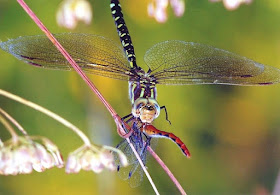
Did you know that one Dragonfly can eat over hundreds of mosquito's a day. Keep some beautiful plants in your yard to attract Dragonflies. It’s possible to help reduce mosquito populations around your house without using nasty chemicals. Did you know that dragonflies are the biggest predators of mosquito's and can eat hundreds of them a day? This makes them a great addition to your garden and the safest natural pest control. They keep mosquito population in check.
Dragonflies eat mosquitoes, both at the larval stage and as adults. Having a few dragonflies in your backyard will ensure mosquitoes do not trouble you during a high mosquito season. Another interesting fact is that Dragonflies are carnivorous in their minds, bodies and soul. A fun fact here. A Dragonfly can eat food equal to its own weight in about 30 minutes. Which roughly translates into a you trying to eat as much as 100 lb, let alone in half an hour. We don’t eat that amount of food in a week!
From the time they get out of their eggs as little nymphs, their limbs and mouth yearn for meat and seek out prey underwater. They are extremely fast swimmers and will eat just about anything that moves under the water surface and on. They have a hyper-thrust mechanism to give them the extra speed-boost when they are pursuing a critter that gives the Dragonfly nymph a run for its money. For a quick burst of speed, they eject water from their anal opening to act like a jet propulsion system, which makes it a near impossible feat for the nymph Dragonfly’s prey to even think of an escape.
If you think this is spectacular, wait till you hear this. Occasionally, the nymph will venture out of the water to get a quick snack from the land. It does this with such nonchalance that when seen this way, one would never really consider the dragonfly nymph to be primarily aquatic, and never ‘ever’ an aquatic insect with gills. As Nymphs, the Dragonflies eat mosquito larvae, other aquatic insects and worms, and for a little variety even small aquatic vertebrates like tadpoles and small fish.
 |
| Dragonfly catching mosquito's at a pond |
Adult Dragonflies are born rulers of their domain and they prove it to just about every insect that thinks it can pull a fast one on this killing machine. The adult dragonfly uses the basket formed by its legs to catch insects while flying. The adult Dragonfly likes to eat gnats, mayflies, flies, mosquitoes and other small flying insects. They sometimes eat butterflies, moths and bees too.
From bees to mosquitoes, Dragonflies make a meal out of what they please and can hunt down insects on a whim, callously plucking them out of thin air after out-flying outmaneuvering and them in the chase that does not normally last very long.
To give you a little insight, the dragonfly that is many times the size of a mosquito or a housefly needs to flap its wings a mere 30 times a minute when compared to a mosquito’s 600 times a minute and the housefly’s 1000 flaps a minute requirement to keep them flying and in peak maneuverability. Such is the power that the dragonfly is equipped with and given its low-energy speed capability, very, very few insects can escape its basket shaped grabbing limbs that it uses to clutch on to its prey before crushing the critter into a gooey mass, with its powerful mandibles and swallowing it.
Adult Dragonflies eat just about anything that is edible and can be caught. They are a treasure for humanity because they keep mosquito populations under strict control by feasting on them when they are in abundance. Similarly, they also feed on ants, termites, butterflies, gnats, bees and other insects and tend to hunt in groups when large colonies of ants or termites are spotted.
They are considered a pest by apiaries because they can polish off a good chunk of the bee population before one can realize the threat looming large.
Writing about what dragonflies eat makes one wonder what would be the case if some of the older dragonfly species that have been found as fossils existed today. These fossil species belonging to the Meganeura genus were carnivorous insects with wings spreading to spans in the range of two and a half feet and made their food out of other insects and even small amphibians. If they were still alive today, we’d have to constantly watch our small pets to be sure they didn’t end up a Dragonfly’s lunch!
Some plants that attract Dragonflies are floating plants that are not rooted under the water are also necessary for any dragonfly habitat. Females will lay their eggs on the underside of the plant or on the stems. The Western water lily is hardy in zones 10 and 11 and fanworts, which will grow in zones 6 through 11, are attractive options. Emergent plants are those that are rooted on the bottom of ponds but have stems and leaves that rise out of the water. Dragonflies love these plants because they use them during both nymph and adult stages. Water horsetail grows well in zones 4 through 11 and is a lovely dark green emergent plant that has a hollow stem with a few branches.
Please click here for more information on --> Chinese Penjing Bonsai
Please click here for more information on --> The Origins of Bonsai
Please click here for more information on --> The Art of Saikei Bonsai
Please click here for more information on --> Japanese Tanuki Bonsai
Please click here for more information on --> How to Water a Bonsai
Please click here for more information on --> Bonsai Healing Methods

No comments:
Post a Comment